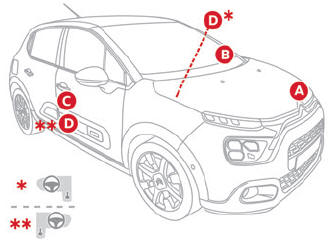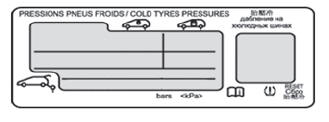Citroen C3: Technical data / Identification markings
Citroen C3 2016-2025 Owners Manual / Technical data / Identification markings
Various visible markings for vehicle identification and vehicle search.

A. Vehicle Identification Number (VIN), under the bonnet.
Stamped on the chassis.
B. Vehicle Identification Number (VIN), on the dashboard.
Printed on an adhesive label visible through the windscreen.
C. Manufacturer's label.
- Affixed to the right-hand door.
- Bears the following information:
- Manufacturer’s name.
- European whole vehicle type approval number.
- Vehicle Identification number (VIN).
- Gross vehicle weight (GVW).
- Gross train weight (GTW).
- Maximum weight on the front axle.
- Maximum weight on the rear axle.
D. Tyres/paint code label.

Affixed to the driver's door.
Bears the following information about the tyres:
- Tyre pressures, unladen and laden.
- Tyre specification, made up of the dimensions and type as well as the load and speed indices.
- Spare tyre inflation pressure.
Also indicates the paint colour code.
 The
vehicle may be originally equipped
with tyres with higher load and speed
indices than those indicated on the label,
without affecting tyre pressure (on cold tyres).
The
vehicle may be originally equipped
with tyres with higher load and speed
indices than those indicated on the label,
without affecting tyre pressure (on cold tyres).
 Dimensions
Dimensions
(..
 Touch screen BLUETOOTH audio system
Touch screen BLUETOOTH audio system
Multimedia audio system - Bluetooth® telephone
The
functions and settings described
vary according to the vehicle version and
configuration.
For safety reasons and
because they
require sustained attention by the driver,
the following operations must be carried out
with the vehicle stationary and the ignition
on:
Pairing the smartphone with the system in
Bluetooth mode...
Other information:
Citroen C3 2016-2025 Owners Manual: 5-speed manual gearbox
Engaging reverse gear Fully depress the clutch pedal. Push the gear lever fully to the right, then backwards. Only engage reverse gear when the vehicle is stationary with the engine at idle. As a safety precaution and to facilitate starting the engine: Always select neutral...
Citroen C3 2016-2025 Owners Manual: Advice
An incorrectly installed child seat compromises the child's safety in the event of an accident. Ensure that there is no seat belt or seat belt buckle under the child seat, as this could destabilise it. Remember to fasten the seat belts or the harness of child seats, keeping the slack relative to the child's body to a minimum, even for short journeys...
Categories
- Manuals Home
- 3rd Generation C3 Owners Manual
- 3rd Generation C3 Service Manual
- Automatic air conditioning
- Starting using another battery
- AdBlue® (BlueHDi)
- New on site
- Most important about car
Copyright © 2025 www.citroenc3.org
